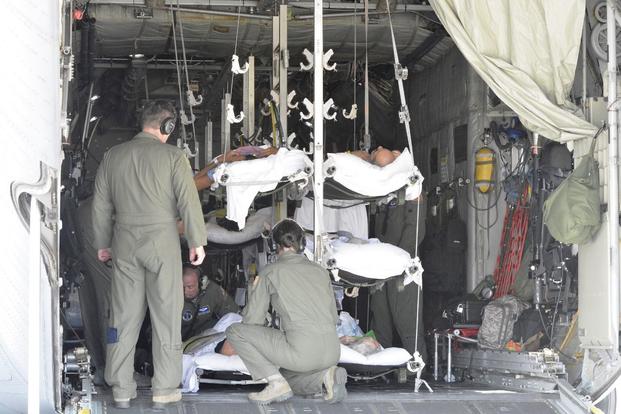Hurricane Irma's northern eyewall hit the Florida Keys at daybreak Sunday as first responders across the state hunkered down in place and the military prepared a massive rescue and relief response.
In a Facebook post, the skeleton crew of sailors who remained near Naval Air Station Key West said, "We're still safe. Conditions are rough. We have power in the main building and breakfast and as soon as there's a lull we'll congregate there." The Navy said 36 personnel from NAS Key West were at a Category 5-rated hotel near the base.
Last week, more than 5,000 personnel and their families at NAS Key West evacuated to Georgia at the direction of Rear. Adm. Bette Bolivar, commander of Navy Region Southeast. Naval Station Mayport near Jacksonville, Florida, and other military installations across the state were shut down until the storm passes.
"We're ready," said Coast Guard Rear Adm. Peter Brown, commander of the Coast Guard's 7th District that has the main responsibility for Irma response. He told CBS early Sunday that the Coast Guard "has made very operational or our service available -- even people from Alaska and Hawaii" to cope with the storm.
Related content:
- Air Force Flies 300 Doctors to Florida for Irma Recovery
- Predator, Reaper Drones Flying to Monitor Harvey, Irma Aftermath
- Aircraft Carrier Lincoln Heading to Florida for Irma Response
The Department of Defense has named several installations as staging areas for post-Irma support operations, including Maxwell Air Force Base, Alabama; Joint Base McGuire-Dix-Lakehurst, New Jersey; Fort A.P. Hill, Virginia; Moody Air Force Base, Georgia; Fort Bragg, North Carolina; and Robins Air Force Base, Georgia.
The 400-mile wide Category 4 Irma with sustained winds of 130 mph and gusts to 160 mph was expected to proceed on a track up the state's west coast and into Georgia, and produce storm surges of 6-15 feet and widespread flooding on Florida's Gulf and Atlantic coasts.
"It's pretty nasty here," Mayor Bill Barnett of Naples, Florida, on the Gulf Coast told MSNBC well before the brunt of the storm reached his area. Mayor Jack Seiler of Fort Lauderdale on the Atlantic coast said "the federal government seems ready, willing and able to do their job.
More than 100,000 residents of Broward County were already without power before the storm hit the area.
In advance of the storm, Gov. Rick Scott, R-Florida, activated the entire Florida Army and Air National Guard -- about 7,000 available members -- to help with planning, logistics and support. The governor said that 1,000 high water vehicles, 13 helicopters, 17 boats and more than 700 generators were on standby.
In addition, the National Guard Bureau has identified approximately 30,000 troops, 4,000 trucks, 100 helicopters and air evacuation crews that are standing by for Hurricane Irma support.
At the presidential retreat at Camp David, Maryland, on Saturday, President Donald Trump convened a Cabinet meeting ahead of the storm for briefings on the progress of Irma and the following Hurricane Jose, which the National Hurricane Center said took a turn to the north to spare many of the Caribbean islands already devastated by Irma.
Trump directed all federal agencies to back the Federal Emergency Management Agency to "continue supporting state and local efforts to save lives, promote shelter efforts, and expedite requested assistance to affected areas," the White House said.
The president also amended the disaster declaration for the U.S. Virgin Islands to increase from 75 percent to 90 percent the level of federal cost sharing for debris removal, emergency protective measures, and federal assistance, the White House said.
"Search and rescue forces, strategic and vertical lift, planning, communication and medical capabilities are on 'Prepare to Deploy Orders' to facilitate a timely post-landfall response" in Florida once the storm passes, the Pentagon said.
The Army said Saturday night that active duty, Reserve and Army National Guard personnel were either already involved in the Irma response or preparing to give support.
The land service response by Saturday included more than 7,400 soldiers and U. S. Army Corps of Engineers civilians in the U.S. Virgin Islands, Puerto Rico, and the continental United States, the Army statement said. More than 140 aircraft, 650 trucks, 150 boats and additional assets were on standby.
Army National Guard Soldiers from Florida, South Carolina, Puerto Rico and the Virgin Islands are currently on state active duty status and are either responding, or prepared to respond to each governor's priorities, the Army said.
In addition, National Guard units in Florida, Alabama, Georgia, South Carolina, and North Carolina are conducting routine inactive duty training, which they will utilize to prepare for a Hurricane Irma response, the Army said.
On Friday, the aircraft carrier Abraham Lincoln, the amphibious assault ship Iwo Jima and the transport dock ship New York left Norfolk, Virginia, to be in position for the Irma response effort once the storm passes. The three-ship group was to be joined by the Arleigh Burke-class destroyer Farragut.
The amphibious assault ships Wasp and Kearsarge, with Marines from the 26th Marine Expeditionary Unit based at Camp Lejeune, North Carolina, and the dock landing ship Oak Hill were already providing relief in the U.S. Virgin Islands and Puerto Rico.
U.S. Northern Command and U.S. Transportation Command were on standby to respond to state requests for strategic lift to move responders from the Department of Health and Human Services to Florida to support aeromedical evacuation of up to 560 patients per day, the Pentagon said.
-- Richard Sisk can be reached at Richard.Sisk@Military.com,






























